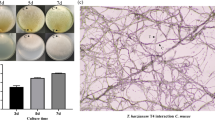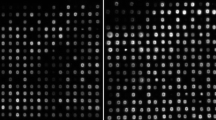Abstract
The filamentous fungus Trichoderma harzianum, strain IMI 393899, was able to grow in the presence of the heavy metals cadmium and mercury. The main objective of this research was to study the molecular mechanisms underlying the tolerance of the fungus T. harzianum to cadmium. The suppression subtractive hybridization (SSH) method was used for the characterization of the genes of T. harzianum implicated in cadmium tolerance compared with those expressed in the response to the stress induced by mercury. Finally, the effects of cadmium exposure were also validated by measuring the expression levels of the putative genes coding for a glucose transporter, a plasma membrane ATPase, a Cd2+/Zn2+ transporter protein and a two-component system sensor histidine kinase YcbA, by real-time-PCR. By using the aforementioned SSH strategy, it was possible to identify 108 differentially expressed genes of the strain IMI 393899 of T. harzianum grown in a mineral substrate with the addition of cadmium. The expressed sequence tags identified by SSH technique were encoding different genes that may be involved in different biological processes, including those associated to primary and secondary metabolism, intracellular transport, transcription factors, cell defence, signal transduction, DNA metabolism, cell growth and protein synthesis. Finally, the results show that in the mechanism of tolerance to cadmium a possible signal transduction pathway could activate a Cd2+/Zn2+ transporter protein and/or a plasma membrane ATPase that could be involved in the compartmentalization of cadmium inside the cell.


Similar content being viewed by others
References
Price MS, Classen JJ, Payne GA (2001) Aspergillus niger absorbs copper and zinc from swine wastewater. Biores Technol 77:41–49
Zafar S, Aqil F, Ahmad I (2007) Metal tolerance and biosorption potential of filamentous fungi isolated from metal contaminated agricultural soil. Biores Technol 98:2557–2561
Benítez T, Rincón AM, Limón MC, Codón AC (2004) Biocontrol mechanisms of Trichoderma strains. Int Microbiol 7:249–260
Mukherjee PK, Horwitz BA, Herrera-Estrella A, Schmoll M, Kenerley CM (2013) Trichoderma research in the genome era. Annu Rev Phytopathol 51:105–129
Grigoriev IV, Nordberg H, Shabalov I, Aerts A, Cantor M et al (2012) The genome portal of the department of energy joint genome institute. Nucleic Acids Res 40:D26–D32
Adams P, De-Leij FAAM, Lynch JM (2007) Trichoderma harzianum Rifai 1295-22 mediates growth promotion of crack willow (Salix fragilis) saplings in both clean and metal-contaminated soil. Microb Ecol 54:306–313
Altomare C, Norvell WA, Bjorkman T, Harman GE (1999) Solubilization of phosphates and micronutrients by the plant-growth-promoting and biocontrol fungus Trichoderma harzianum Rifai 1295–22. Appl Environ Microbiol 65:2926–2933
Cao L, Jiang M, Zeng Z, Dub A, Tan H, Liu Y (2008) Trichoderma atroviride F6 improves phytoextraction efficiency of mustard (Brassica juncea (L.) Coss. var. foliosa Bailey) in Cd, Ni contaminated soils. Chemosphere 71:1769–1773
Errasquın EL, Vazquez C (2003) Tolerance and uptake of heavy metals by Trichoderma atroviride isolated from sludge. Chemosphere 50:137–143
Gimmler H, de Jesus J, Greiser A (2001) Heavy metal resistance of the extreme filamentous fungus Bispora sp. Microb Ecol 42:87–98
Ramesh G, Podila GK, Gay G, Marmeisse R, Reddy MS (2009) Different patterns of regulation for the copper and cadmium metallothioneins of the ectomycorrhizal fungus Hebeloma cylindrosporum. Appl Environ Microbiol 75:2266–2274
Lewinson O, Lee AT, Rees DC (2009) P-type ATPase importer that discriminates between essential and toxic transition metals. PNAS 106:4677–4682
Momose Y, Kitagawa E, Iwahashi H (2001) Comparison of genome wide expression patterns in response to heavy metal treatment in Saccharomyces cerevisiae 1) Cadmium and mercury. Chem Bio Inform J 1:41–50
de Freitas Lima A, de Moura GF, de Lima MAB, de Souza PM, de Silva CAA, de Campos Takaki GM, do Nascimento AE (2011) Role of the morphology and polyphosphate in Trichoderma harzianum related to cadmium removal. Molecules 16:2486–2500
Raspanti E, Cacciola SO, Gotor C, Romero LC, García I (2009) Implications of cysteine metabolism in the heavy metal response in Trichoderma harzianum and in three Fusarium species. Chemosphere 76:48–54
Puglisi I, Faedda R, Sanzaro V, Lo Piero AR, Petrone G, Cacciola SO (2012) Identification of differentially expressed genes in response to mercury I and II stress in Trichoderma harzianum. Gene 506:325–330
Hu W, Tedesco S, Faedda R, Petrone G, Cacciola SO, O’Keefe A, Sheehan D (2010) Covalent selection of the thiol proteome on activated thiol sepharose: a robust tool for redox proteomics. Talanta 80:1569–1575
Mendoza-Cozati D, Loza-Tavera H, Hernandez-Navarro A, Moreno-Sanchez R (2005) Sulfur assimilation and glutathione metabolism under cadmium stress in yeast, protests and plants. FEMS Microbiol Rev 29:653–671
Toone WM, Jones N (1998) Stress-activated signalling pathways in yeast. Genes Cells 3:485–498
Saiano F, Ciofalo M, Cacciola SO, Ramirez S (2005) Metal ion adsorption by Phomopsis sp. biomaterial in laboratory experiments and real wastewater treatments. Water Res 39:2273–2280
Morgulis A, Coulouris G, Raytselis Y, Madden TL, Agarwala R, Schäffer AA (2008) Database indexing for production MegaBLAST searches. Bioinformatics 24:1757–1764
Altschul SF, Madden TL, Schäffer AA, Zhang J, Zhang Z, Miller W, Lipman DJ (1997) Gapped BLAST and PSI-BLAST: a new generation of protein database search programs. Nucleic Acids Res 25:3389–3402
Marchler-Bauer A et al (2011) CDD: a Conserved domain database for the functional annotation of proteins. Nucleic Acids Res 39:225–229
Demontis MA, Cacciola SO, Orrù M, Balmas V, Chessa V, Maserti BE, Mascia L, Raudino F, di San Magnano, Lio G, Migheli Q (2008) Development of real-time PCR systems based on SYBR® Green I and TaqMan® technologies for specific quantitative detection of Phoma tracheiphila in infected Citrus. Eur J Plant Pathol 120:339–351
Heid C, Stevens J, Livak K, Williams P (1996) Real time quantitative PCR. Genome methods: genome research. Cold Spring Harbor Laboratory Press, Cold Spring Harbor
Lo Piero AR, Mercurio V, Puglisi I, Petrone G (2010) Different roles of functional residues in the hydrophobic binding site of two sweet orange tau glutathione S-transferases. FEBS J 277:255–262
Faedda R, Puglisi I, Sanzaro V, Petrone G, Cacciola SO (2012) Expression of genes of Trichoderma harzianum in response to the presence of cadmium in the substrate. Nat Prod Res 26:2301–2308
Faedda R, Puglisi I, Lo Piero AR, Petrone G, Cacciola SO (2008) Glutathione transferase activity and identification of differentially expressed genes in Trichoderma harzianum grown with heavy metals. J Plant Pathol 90:S2.96 18.3
Shimada H, Tominaga N, Kohra S, Ishibashi H, Mitsui Y, Ura K, Arizono K (2003) Metallothionein gene expression in the larvae of Caenorhabditis elegans is a potential biomarker for cadmium and mercury. Trace Elem Electrolytes 20:240–243
Axelsen KB, Palmgren MG (1998) Evolution of substrate specificities in the P-type ATPase superfamily. J Mol Evol 46:84–101
Appleyard MVCL, McPheat WL, Stark MJR (2000) A novel `two-component’ protein containing histidine kinase and response regulator domains required for sporulation in Aspergillus nidulans. Curr Genet 37:364–372
Chang C, Stewart RC (1998) The Two-component system. Regulation of diverse signaling pathways in prokaryotes and eukaryotes. Plant Physiol 117:723–731
van der Lelie D, Schwuchow T, Schwidetzky U, Wuertz S, Baeyens W, Mergeay M, Nies DH (1997) Two-component regulatory system involved in transcriptional control of heavy-metal homoeostasis in Alcaligenes eutrophus. Mol Microbiol 23:493–503
Gadd GM (2009) Heavy metals pollutants: environmental and biotechnological aspects. Encyclopedia of microbiology, 3rd edn. Elsevier, Oxford, pp 321–334
Acknowledgments
This research was supported by the University of Catania PRA program Grants of Prof. Petrone and Prof. Cacciola. The Authors wish to thank Mrs. Ann Davies Muni for the English revision of the text.
Author information
Authors and Affiliations
Corresponding authors
Additional information
Ivana Puglisi and Roberto Faedda have contributed equally to the research.
Rights and permissions
About this article
Cite this article
Cacciola, S.O., Puglisi, I., Faedda, R. et al. Cadmium induces cadmium-tolerant gene expression in the filamentous fungus Trichoderma harzianum . Mol Biol Rep 42, 1559–1570 (2015). https://doi.org/10.1007/s11033-015-3924-4
Received:
Accepted:
Published:
Issue Date:
DOI: https://doi.org/10.1007/s11033-015-3924-4




